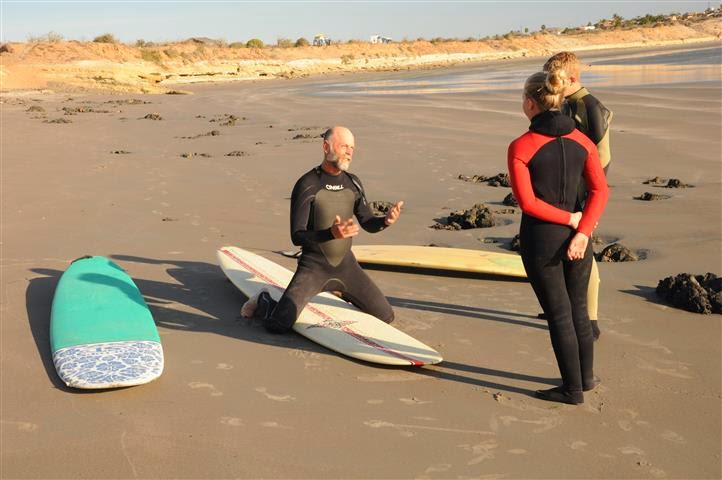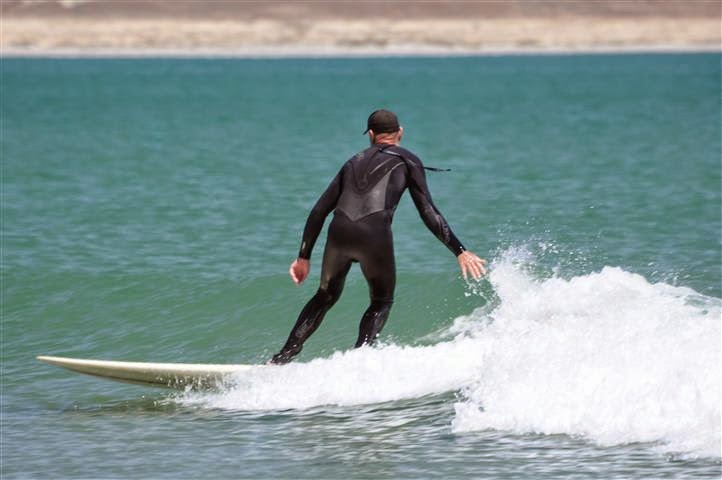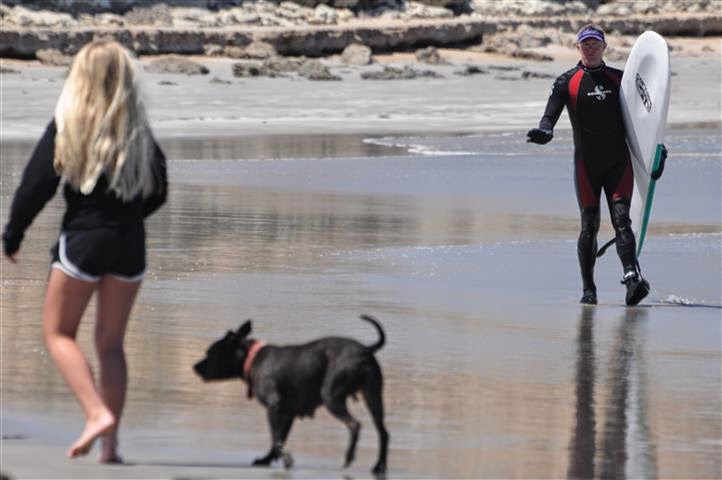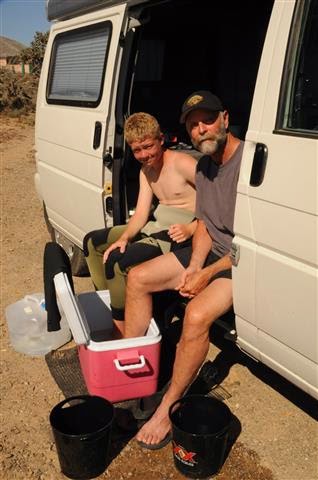By TC
Back in March 2012, Sylvia and I flew from Palo Alto, Calif to
Loreto, Mexico in a small plane (a Cessna 180 taildragger) for a long weekend
to visit Baja and get up close with the grey whales at the World Heritage Site
of Laguna San Ignacio. Our good pals and
fellow pilots Mary and Lou had the plane and previous Mexico experience to pull
this off, and thus, we had a fun and memorable adventure.
.JPG) |
| 2012 – At the Loreto, Mexico Int’l Airport after 7 hr flight from the SF Bay Area. |
At the whale sanctuary in San Ignacio Lagoon, however, there
was a map of Baja that had a curious little notation about a famous surf break
just down the coast. After visiting with numerous mother whales and calves, we
departed the dirt airstrip at San Ignacio to return to Loreto and our hotel for
the night. During the flight, we flew down the Pacific coast to check out the famous
surf break from the air. The whole coast of Baja is wild, mostly undeveloped,
and has a rugged desert beauty which keeps travelers allured, as we were. As we overflew Scorpion Bay/San Juanico Bay,
we saw blue/white ‘rays’ of long peeling waves stemming from a peninsula with about
6 right hand point breaks, reminiscent of storied Rincon or Malibu breaks in
So. Cal. Incredibly, only a few surfers
were enjoying these uncrowded Mexican waves. After flying a couple of lazy circles gawking
at the remote breaks and the dusty nearby town, we turned toward Loreto and I had
become enamored with the idea of surfing this place.
.JPG) |
| 2012 - Dirt airstrip on the Pacific Coast of Baja (San Ignacio) normally desolate, but on this day it was busy with other planes from our Baja Bush Pilots group. |
.JPG) |
2014 – Juicier waves at one of the inside breaks.© D. Davidson
|
Three years later, the chance to surf San Juanico finally
materialized. With Sylvia magnanimously agreeing to remain with Cinnabar (at
anchor in B. Concepcion) for a few days, my friends and I loaded up 2 vehicles with surfboards
and supplies for the 4 hour road trip from Mulege across the 1000 mile long
Baja Peninsula. Literally, from sea to shining sea (Cortez to Pacific). The
truck was full with Captain Mike and his teenage kids (Kelston & Savanah from Colorado) while our
other friends BobbyD and Denise piloted their VW EuroVan (visiting from Santa Cruz,
CA; ironically, they live one block from the Cowels/Steamers surf break but don't surf it much).
.JPG) |
| Road warriors on Mex 1 – Surf guide, Vanagan, boards. |
.JPG) |
| With gas stations 100 miles apart – gotta fuel up at every chance. In a sleepy town, we stopped to ask “Where’s the Pemex”. The local in the beat-up truck said “right here”. We turned to see a simple house with a jankily-wired, 110V electric pump for dispensing gas out of 50 gal plastic barrels. Ah…OK…fill er up! |
.JPG) |
| Great viewing on the cliffs above the surf break. |
We booked a giant palapa (palm hut) on the cliff
right above one of the best breaks and for the next 4 days, we surfed our arms
off on the small but well-shaped, frequent, and long peeling waves.
.JPG) |
| Our 'camp' 50 yards from the beach - the rustic palapa sleeps 6, no electricity or plumbing, only occasional scorpions and ants. |
There was a small contingent of locals here and there and a generally friendly vibe. Everybody got good waves, including our new learners. Many of the rides were hundreds of yards long - fun as heck. It was perfect for getting back into the surf groove after a hiatus of 3-4 years. If the small conditions were this much fun, I could imagine that the excitement meter goes off the charts when the place gets some sizable swell. We felt very fortunate to get Rincon quality waves without the hordes and attitudes of crowded US breaks.
.JPG) |
| The veteran gives the learners a few pointers.© M. McGuire |
.JPG) |
| 'Goofy' Kelston got the hang of it quickly and was soon scoring many rides.© D. Davidson |
.JPG) |
| © Savanah - also getting the hang of it. |
.JPG) |
| Bobby milking a 'musher' until it walls up in the shallows.© D. Davidson |
.JPG) |
Tom zipping down the line. The pacific water and wind were cool-ish on some days.
© D. Davidson |
.JPG) |
Mike returning after a long distance cruise. It was often easier to walk rather the paddle back.
© D. Davidson |
.png) |
| © Tom gliding on the Big Yellow Taxi |
The only fly in the ointment was the stingrays in the sand –
3 of our group got nailed, with BobbyD getting the worst/bloodiest strike. It
put them out of action for a while, but with lots of hot water and ointment,
they were back on the fiberglass in short order. Apparently, the stingrays are a common summer
problem, arriving with the warmer water. But, they happened to be “in” early
this year.
.JPG) |
Kelston and BobbyD treating the stingray pain and toxin by soaking in very hot water.
© D. Davidson |
.JPG) |
Thinking of your our own slice of Baja paradise, cheap? Off-the-grid trailer enhanced with deck, shade, and 2nd story sun tower!
The giant bay, 20 mile long beach, rocky sea cliffs, distant
mountains, endless ocean horizon, and
general remoteness give the place a lonely ‘ends of the earth’ feel. It is a special place though not just because
of the geography and good surf, but also because of the ocean bounty. It feels like it could get ‘discovered’ and
eventually spoiled, like with so many other fine places humans want to turn
into Disneyland (e.g. Cabo, Cancun,
Vallarta, etc.). in fact, there is a sizeable fishing co-op here (170 members)
and they are actively campaigning against big corporate interests that want to
exploit the area – the latest is a German mining interest that wants to build a
harbor (and wreck the breaks/beaches) and mine some type of (toxic) phosphorous
modules on the nearby sea beds. The co-op fisherman seem wise and suspicious to
the corporate promises of plentiful jobs, good pay, progress, and commerce for the
area. They like their fishing jobs
(generational) and apparently keep their fisheries sustainable by regulating
the take, the season durations, and the species (grouper, tuna, lobsters, squid,
octopi, etc.).
|
.JPG) |
Fishing pangas on the beach during a wind storm.
|
The fisherman told us a surprising note about their lobster
fishery. They catch the clawless California Spiny Lobster and their main market
is in China. The local lobster are
trapped (when in season), put into local storage tanks and drugged to make them sleep. The bugs are then transported via truck
500 miles north to Ensenada where they are put into recovery tanks. After some
time there (a few days?), they are then drugged
again and flown by jet direct to
China for sale as live seafood. The
carbon footprint of this excessively long supply chain makes me rather discouraged.
Does China really need to eat lobster
from halfway around the world when the tasty crustaceans are in short supply locally here in
Mexico and California?? I don’t fault
the fisherman, they are probably only selling to the highest bidder and managing
the resource well (they say). This seems
like another example of why eating locally is an important, better all-around
community choice.
.JPG) |
| Fishing co-op panga setting out with traps. Interestingly, the co-op also uses 'vigilantes' to patrol their fishing area for poachers. © D. Davidson |
Although I still have
yet to realize the ultimate dream of paddling into surf directly from Cinnabar*,
it was a real thrill to finally surf/explore San Juanico after ‘discovering it’
for the first time from the air. I currently have no paddling fitness and my
water skills are rusty, but I was elated to be surfing with great friends, lots
of waves, in an uncrowded place, for
multiple days, with no other cares. Freedom, indeed!
.JPG) |
| Maybe the place should be renamed Stingray Bay?! © M. McGuire |
*Once, I technically paddled into surf from Cinnabar at Drakes Bay, CA . The shorebreak was small and
closing out with no real rides to be had, so I don’t count this as a legit
session.
.JPG)
.JPG)
.JPG)
.JPG)
.JPG)
.JPG)
.JPG)
.JPG)
.JPG)
.png)
.JPG)
.JPG)
.JPG)
.png)
.JPG)
.JPG)
.JPG)
.JPG)
.JPG)
.JPG)
Capt Sharkbait, great blog! I am a recent transplant to San Diego and I am building my knowledge for a trip to Baja. I also have a Cessna 180, so I would like to use that for surveying sites before I drive my family down (includes a toddler) with food, boards, tent, etc. Is there anyway to contact your 180 pilot? And have you gone down recently or with the Cinnabar? Thanks for the help, Jimmy Francis (jimmyfrancis69@hotmail.com)
ReplyDelete